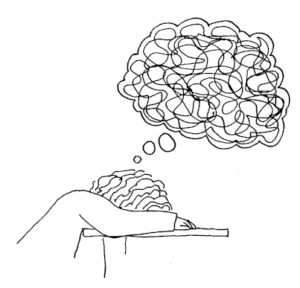The elephant in the room… it’s that thing everyone knows is there but is ignoring. As we ignore the elephant it becomes more and more obvious. It starts to take up more room than you’d like it to.
This metaphor has been going around my head since I used it with a client who has been struggling with anxiety for years. I used the metaphor to explain how our anxious thoughts tend to behave when we try to suppress them or ignore them.
Anxiety is like an elephant in the room

As we try to ignore our anxious thoughts they have a tendency to become more insistent and intrusive. It becomes more and more difficult to keep going… and the physiological symptoms of anxiety and frustration start to intensify.
The physical experience of anxiety
Our breathing becomes more shallow and increases pace, our heart rate rises, we become tense and struggle to focus our thinking. We might struggle to eat, feel nauseous or sick, feel restless or fidgety and we might feel hot and sweaty.

Anxiety is adaptive. It’s purpose is to protect us from adversity or threat and ensures our survival. This survival mechanism can be effective in protecting against physical threats to our survival but might be less effective when we face threats to our psychological wellbeing, our identity, or how we want to be viewed by others or ourselves.
Anxious thoughts

When we are having anxious thoughts we are feeling threatened in some way. sometimes these anxious thoughts might not actually be helpful. In fact, they might be very unpleasant. And they might even prevent us paying attention to what we’re doing at any particular moment.
For example, if we are wanting to pay attention to a task but we start thinking about potential failure we might find it very difficult to actually complete the task. Our thoughts end up being focussed on the worry or fear of failure and what this might mean rather than the particular process we need to follow and the potential success of completing the task.
Noticing, choosing, attention…
What if we allow ourselves to notice the anxiety, notice the anxious thoughts, gently allow those thoughts to float in and out of our mind, and choose where we place our attention? If we notice the elephant in the room, notice and acknowledge the anxiety we feel, the elephant might begin to shrink.
When we notice and acknowledge our anxiety and gently shift our attention to what we’d like to attend to we might begin to notice our our experience of anxiety change. This is the practice of mindfulness; gently paying purposeful attention to a chosen stimulus.
Mindfulness of breath
We can chose to pay attention to our breathing, to a sensation from one of our five senses, or to a particular behaviour. by making this choice to pay attention to our breathing, for example, we might begin to notice that our breathing slows down, we might begin to be able to notice those uncomfortable anxious thoughts and gently let them go.
We might start to notice that the elephant in the room is no longer taking up space meaning that breathing is a struggle. we might notice that the elephant is smaller and more manageable. Maybe it’s small enough that it can sit beside you on the couch. Every now and then it reaches over and taps you on the shoulder with it’s trunk as if to say “hey, remember me… I’m still here”. As you continue to practice mindfulness you will learn to continually notice, acknowledge and shift  your attention to where you’d like to place it. And maybe the elephant is becoming small enough to sit like an ornament on your desk or coffee table.
your attention to where you’d like to place it. And maybe the elephant is becoming small enough to sit like an ornament on your desk or coffee table.
And maybe you can pick up the elephant and put it in your pocket. Every now and then the elephant will trumpet or grow a little or tap you on the shoulder just reminding you that it’s there… but with ongoing mindfulness practice you will be able to acknowledge the anxiety and shift your attention to your valued action.
Are you ready to learn a little more about how to manage your elephant in the room? You can contact me at no***@en*********.com to learn more.
You might like to have a look at this article about mindfulness to learn more about how it can change your brain.
Image Credits
http://www.bushcampcompany.com/elephants_in_reception.php
Jared Rice Unsplash
